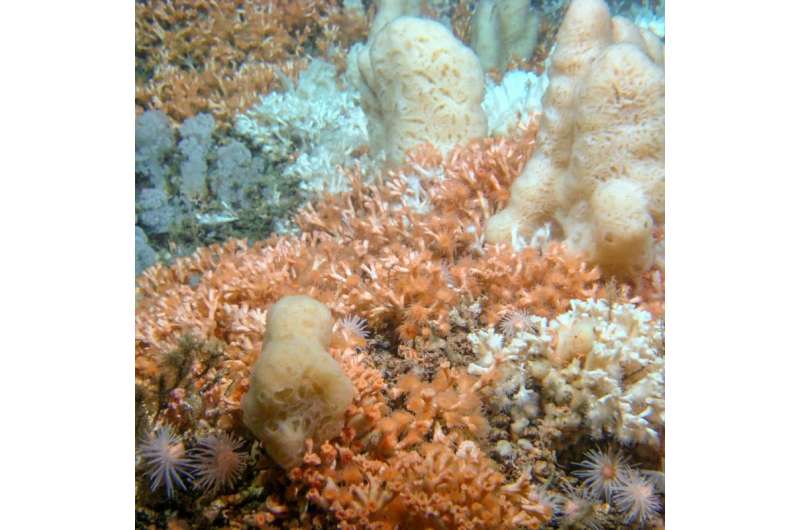Scientists go high-tech to study fragile cold-water reefs

Coral reefs are generally associated with warm, shallow and crystal-clear waters in the tropics. Other species of coral, however, flourish in the deep cold ocean where they also form large reefs. Now researchers from the University of Southern Denmark have applied a technique to study these important and fragile cold water reefs without affecting them or altering their surrounding physical environment.
In tropical reefs, the large diversity of species inhabiting the reef is evident to the naked eye. Cold-water coral reefs, in contrast, are less known to the public, despite having a much larger global distribution than tropical reefs. These reefs can be found in subarctic waters in hundreds of meter depth as well as at thousand-meter depths at subtropical and tropical latitudes.
Although their existence was already documented in the 18th century, it is only thanks to recent advances in underwater technology that it was possible to investigate such otherwise hidden reefs. The results of those studies have highlighted the vast damage that years of deep-sea trawling have caused and still cause to the reefs. In addition cold-water coral reefs and their biodiversity are also threatened by ongoing ocean warming and ocean acidification. However, still the reefs, their inhabitants, and their importance for local and global element cycles are unknown.
Going down to where the corals live
"Traditionally the metabolism of cold-water reefs are typically investigated by collecting animals and analyzing them in a laboratory. Preferably, however, researchers would like to do the opposite, and bring the laboratory to the seabed, where the reef can be studied in its own environment. Since cold water reefs grow incredibly slowly - about 5 mm per year - and are fragile habitats, we were looking at novel techniques that could be used on a reef to asses metabolism with little impact on the reef structures", says Dr. Lorenzo Rovelli, Scottish Association for Marine Science (SAMS), visiting researcher at the Nordic Center for Earth Evolution (NordCEE), Department of Biology, University of Southern Denmark.

NordCEE researchers, Prof. Ronnie N. Glud and Dr. Karl Attard, joint forces with researchers from UK institutions SAMS and Heriot-Watt University, and GEOMAR - Helmholtz Centre for Ocean Research in Kiel, (Germany) in a cooperative effort to apply a new type of non-invasive equipment for the investigation of two reefs.
The 20 km long Mingulay Reef Complex in the Sea of Hebrides, off Scotland, at a depth of 128 m and on the 30 km long Stjernsund in Northern Norway, at 220 m depth. To precisely position the small office desk- sized equipment on the reef, they used remotely operated vehicles (ROVs). ROVs are equipped with high-resolution cameras and robotic arms that enable the researchers to locate the most suitable location and to safely deploy their equipment where they will autonomously start their measurements.
Cold water reefs turn over carbon
"We are particularly interested in finding out how much carbon is being turned over by a reef - and by that I mean the whole reef community. The community consists of the corals, which are the engineers behind the reef structure, as well as all the other organisms that inhabit the reef: from large crabs to microscopic organisms. Currently, we still do not know if and to what extent such reefs are contributing to the global carbon budget".
The equipment used on the reef employs a method termed 'Aquatic Eddy Covariance' to simulaneously measure the content of oxygen in the water and the water flow at high frequencies. With the right sensors and a specific setup, the data can be used to calculate how much oxygen is being absorbed by the reef inhabitants. Furthermore, the approach allows the investigators to assess the O2 consumption rates as a function of environmental drivers like food availability and hydrodynamics.
From the obtained data, we can estimate the total uptake of oxygen by the reef community, which expresses how much carbon is turned over within a defined area of the reef. Our studies showed that these reefs are not only hotspots for biodiversity, but they also turn over a considerable amount of carbon, rivaling shallower coastal environments. This is important knowledge to advance our understanding of the reef functioning, and another step towards quantifying the role of cold-water coral reefs in the global carbon cycle", explains Lorenzo Rovelli.
The joint results from this study on the metabolism of cold-water coral reef communities are published in the journal Marine Ecology Progress Series.
More information: Rovelli, L., K. M. Attard, L. D. Bryant, S. Flögel, H. Stahl, J. M. Roberts, P. Linke, and R. N. Glud (2015) Benthic O2 uptake of two cold-water coral communities estimated with the non-invasive eddy correlation technique. Marine Ecology Progress Series 525: 97–104, DOI: 10.3354/meps11211.
Journal information: Marine Ecology Progress Series
Provided by University of Southern Denmark





















